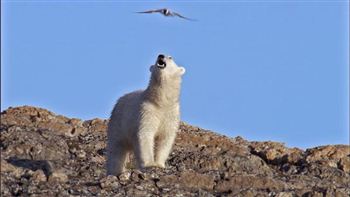BBC documentary Frozen Planet began last night to general acclaim.
In the third instalment of the epic BBC One series polar bears perch precariously on the edge of the ice before taking a leap into the icy water, penguins huddle together for warmth and camera crews get closer than ever before to the polar wildlife.
Frozen Planet broadcasts on BBC One on November 9.
Polar bear faces aerial attack from nesting Arctic tern. Bears scavenge in the seabird colonies when there is little else to eat. But the terns draw blood with their vicious beaks. – (Picture by BBC)
Filming killer whales from a boat in the Antarctic Peninsula. Some orcas are mammal hunters – they kill seals by working as a team to generate large waves that wash them off ice floes.
Others hunt minke whales by hunting them down and drowning them. The orcas dwarfed the 18 foot zodiac and even started to wave wash the team, whilst they were filming. (Picture by BBC/Robert Pitman)
Adelie penguins on iceberg surrounded by masses of floating ice, Western Antarctica. Summer is the time when parents make fishing trips round the clock to feed their growing chicks – Agency picture – (Picture by Yva Momatiuk & John Eastcott / Minden Pictures)
Arctic wolf, Ellesmere Island, Canada. These wolves are extremely remote and unused to humans. It took the crew many weeks before the wolves would allow them to get this close. (Picture by BBC/Mark Smith)
Elephant seal and king penguins on beach, South Georgia. The seal flicks wet sand on its back to keep cool. The elephant seals present an obstacle course to the king penguins who have to navigate around their large blubbery bodies in order to cross the 150 metres between the surf and their colony. (Picture by BBC/Fredi Devas)
Bull fur seals fighting on the beach. The fur flies during their epic battles for supremacy as they compete for mating rights with the females who have just had pups and are now ready to mate again. Bird Island, South Georgia. (Picture by BBC/Ian McCarthy)
The largest ice cap in the Eurasian Arctic:150 miles long with a thousand waterfalls in the summer. Austfonna ice cap, Svalbard. (Picture by BBC/Jason Roberts)
King penguins on beach, St Andrews Bay, South Georgia. There are 400,000 penguins in this one bay alone. (Picture by BBC/Chadden Hunter)
Sunset over Antarctic Peninsula landscape with icebergs. Haunt of killer whales. (Picture by BBC/ Elizabeth White)
Snowy owl female with chicks,Arctic. Each chick eats two lemmings a day so the parents are kept very busy (Picture by BBC/Markus Varesvuo / naturepl.com)
Mother polar bear and two cubs on pack ice, Svalbard. She is sizing up the camera crew as a potential meal whilst they were filming with their aerial camera.
They tried to maintain a distance of 15 metres at all times – but sometimes the polar bears didn’t observe the rules. (Picture by BBC/Jason Roberts)
Icebergs in a bay, South Georgia. Occasionally icebergs that have calved off Antarctica drift north into the bays that surround the sub-Antarctic island. (Picture by BBC/Chadden Hunter)
Polar bear cubs jumping into water. It’s in summer when the pack ice breaks up that the cubs have to learn to swim for the first time. Polar bears are actually marine mammals and are very at home in water as adults. (Picture by BBC/Jason Roberts)
The melting ice forms elegant ice sculptures, Glacial ice in fjord Svalbard. (Picture by BBC)
Polar bear in pack ice, Svalbard summer. As the ice breaks up it becomes harder work. For the polar bears to capture their favoured seal prey, summer is a tough time. (Picture by BBC)
Austfonna ice cap, Svalbard the largest ice cap in the Eurasian Arctic. It’s face is 150 miles long and has a thousand waterfalls in the summer. (Picture by BBC)
Polar bear swimming in front of the Austfonna ice cap, Svalbard. As the pack ice melts in summer they have to spend more of their time swimming further and further to find food. Polar bears (Latin name Ursus maritimus) can swim for 60 miles in a day. (Picture by BBC)
Crew filming polar bear from a boat in pack ice. Frozen Planet is the first series to adapt a stabilised aerial camera and mount it to the front of boats.
This enabled the series to get close to polar bears in their melting summer ice world. It’s impossible for conventional film crews to get so close. (Picture by BBC/John Aitchison)
